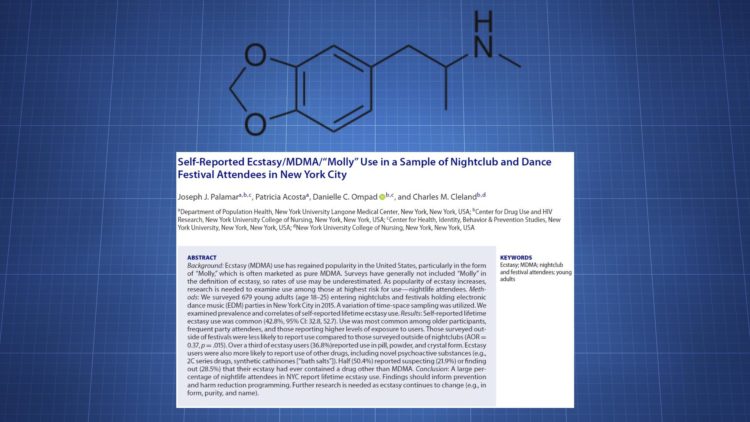Abstract: This paper looks at the rate of MDMA (Ecstasy, Molly) use among young adult nightclub and festival goers. Compared to the general population, people who attend those events have a greater lifetime use rate. Those who take MDMA also report higher rates of drug use overall.
Authors: Joseph J. Palamar, Patricia Acosta, Danielle C. Ompad, and Charles M. Cleland
DOI: 10.1080/10826084.2016.1219373
Link: http://www.tandfonline.com/doi/abs/10.1080/10826084.2016.1219373
Published: September 23, 2016
Contents
Introduction
Background
EDM (electronic dance music) and events connected to it have risen in popularity in the United States. Previous research suggests there’s a strong correlation between EDM event attendance and the use of MDMA (or drugs sold as MDMA).
This study aimed to further investigate the connection between attendance at nightlife events or festivals and the use of MDMA/ecstasy/molly.
An earlier Monitoring the Future (MTF) study using data from 2014 found that high school seniors who went to raves had higher drug use rates and took drugs more often. Overall, 5.6% of seniors reported lifetime MDMA/ecstasy use.
When looking at young adults in the US (ages 19 – 28), an MTF study found 11.4% reported lifetime use.
Along with there being a connection between EDM event attendance and MDMA use, it appears attendees are also more likely to use other drugs, including GHB, cocaine, ketamine, and methamphetamine.
The Study
The present study looked at the use of MDMA among young adults attending nightlife/festival events in New York City (NYC). It aimed to investigate use rates, correlations between attendance and use, and experience with adulteration.
Data from 679 people was collected over 21 nights between July and September 2015. All respondents were 18 to 25 years-old, with a mean age of 21.9.
“Molly” was specifically included in the survey, as there’s reason to believe people may say they’ve used “molly” while not saying the same for “MDMA” or “ecstasy.”
Results
Among this group, the lifetime use rate for ecstasy was 42.8%. The chance of someone reporting lifetime use increased among older participants, those with more education, and those with greater exposure to other ecstasy users. The average rate was lower among those attending EDM festivals compared to nightclubs.
Form of Drug
Here’s the form of MDMA/ecstasy people reported taking:
- Pill/powder/crystal – 36.8%
- Powder only – 18.9%
- Pills only – 18.2%
- Pills & powder – 13.6%
- Crystals alone OR with either pills or powder – 12.5%
Route of Administration
Here’s how people reported taking the drug:
- Oral only – 55.7%
- Oral & intranasal – 34.4%
- “Other” route – 5.1%
- “Other”/intranasal/oral – 3.4%
- Intranasal only – 1.4%
Use of Other Drugs
Significantly higher general drug use rates were seen among those who reported taking ecstasy. This appears to be true for cannabis, cocaine, LSD, methamphetamine, 2C series psychedelics, synthetic cathinones, research chemical (RC) dissociatives, and “unknown liquids.”
Purity & Adulteration
Compared to the UK (and other parts of Europe), adulteration seems to be a greater issue in the US. Pills may contain MDMA in addition to other drugs or they may only contain an alternative substance. The non-MDMA drugs can range from caffeine to methamphetamine to a synthetic cathinone. It’s important for people to know what they’re taking and it’s a vital part of harm reduction.
Here’s the breakdown for people’s experience with adulteration:
- 49.6% have never suspected or learned their ecstasy was adulterated
- 28.5% learned their ecstasy was adulterated
- 21.9% suspected their ecstasy was adulterated
Rate of Attendance & Use
A correlation was found between how often people attend these events and whether or not they’ve used MDMA.
Using 1 – 2 times per month or weekly doubles the chance of reporting lifetime ecstasy use compared to those attending less than once per month.
Summary
In this population, the overall use rate for MDMA/ecstasy was 42.8%. The data supports the view that lifetime use increases with age, which is an expected observation.
People who were surveyed outside of festivals were under half as likely to report ecstasy use compared to nightclub attendees.
The use of ecstasy was correlated with non-MDMA drug use, including research chemicals, psychedelics, and stimulants.









